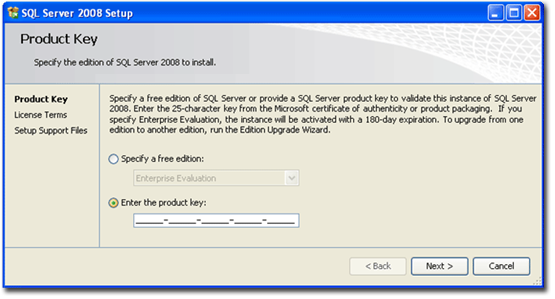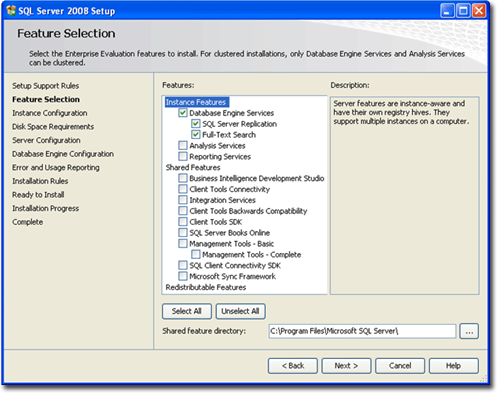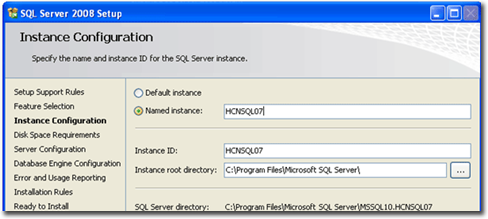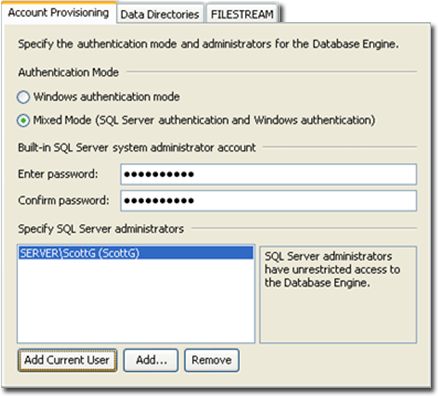SQL Installation Steps
Before you begin
Procedure
- Ensure you are logged in as a user with Administrator privileges.
- Start the SQL Installer.
-
Planning Menu Screen
- Run the System Configuration Checker This will identify any potential issues that could prevent a successful installation. Any issues discovered must be fixed before continuing with the installation.
-
Installation Menu Screen
- Run the New SQL Server stand-alone installation or add features to an existing installation option. This will identify any potential problems that might occur when installing SQL Server Setup support files. Any issues discovered must be rectified before continuing with the wizard.
- If no issues are discovered, click the OK button to continue with the installation.
-
Product Key Screen
- If you are installing one of the Full variations of SQL Server (i.e. not the Express version) you will be prompted to enter a Product Key.
- Alternatively you can install as an evaluation version (subject to Microsoft's policy on evaluation versions, which can include a trial period), by selecting from the drop down box.

-
Feature Selection Screen
- Select the components of SQL Server which you want to install. Select a feature to read a brief description about it in the right-hand panel. Note: The Analysis Server and Reporting Services items can be de-selected, as they are not required for MedicalDirector software.

-
Instance Configuration Screen
- Specify a named instance. MedicalDirector software requires the following instance names be used:
- HCNSQL07
- ESP
- HCNMOB07 (for HCN Mobility role installs)

-
Disk Space Requirement Screen
- You will be notified of the disk space required for the installation of SQL Server. Resolve any disk space issues before continuing.
-
Service Accounts Tab
- SQL Server Browser entry has the Account Name of the built-in System Account – Local System
- Startup Type is set to Automatic.

-
Database Engine Configuration Screen, Account Provision Tab
- Select Mixed Mode authentication.
- The SA Password must adhere to 'strong password' rules (e.g. HcnTemp123$).
- SQL Server Administrators, click the Add Current User button.
- Optional: Data Directories Tab, to specify a non-default installation directory. If required, you can select to install the Databases in a different folder other than the default location. If you are unsure, leave the folder locations with their default values.

- Select Mixed Mode authentication.
-
Error and Usage Reporting Window
- Read the options provided and select as desired.
-
Installation Rules Windww
- A summary will appear, if there are no issues identified, click Next to continue with the installation
- Should any issues be identified, they must be resolved before setup can proceed.
-
Ready to Install Window
- Review the features selected, click the Install button to begin the installation of SQL Server.
-
Installation Progress screen
- Progress can be monitored on this screen, click the Next button to see the installation summary report.
-
Complete window
- The location for the SQL Server Installation Summary log is provided.
- Click Close to complete the SQL Server installation.
-
SQL Server Configuration Manager, via Start > All Programs
- Click on Protocols for HCNSQL07SQL Server Network Configuration.
- Make sure the following protocols are enabled;
- Shared memory
- Named Pipes
- TCP\IP
- Repeat on the ESP instance
-
Restart the Instance Services
- Start > Run > Type Services.msc
- Locate, highlight & restart the following services
- SQL SERVER (HCNSQL07)
- SQL SERVER (ESP)
-
Reinstall Clinical / Pracsoft using the CD for the
version of Medical Director Clinical/Pracsoft you originally had installed.
- Remember to access 'Advanced Options' during the installation, if you do not use a default C: Drive
- Install all MedicalDirector updates and MDref updates to match what is installed on the workstation computers.Note: If the computer is a Terminal Service computer, you will need to ensure that the Terminal Service Manager (Control Panel > Administrator Tools > Terminal Service Manager) lists only the 'Console' login. No other login should be displayed (even if it is in a disconnected state).
- Install any secondary software required (MedicalDirector GPRN Extractor, NSW HealthELink, etc).
- Restore your Medical Director Clinical/Pracsoft Backup.
-
Run Clinical / Pracsoft to ensure all is
working correctly and that the most recent patient data is available, including any
correspondence recorded.
Helix
